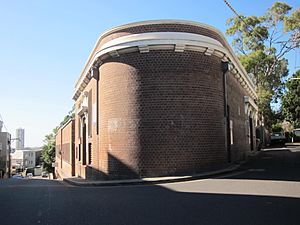Paddington Substation facts for kids
Quick facts for kids Paddington Substation |
|
|---|---|

Paddington Substation, 1 Young Street, Paddington New South Wales
|
|
| Location | 1 Young Street, Paddington, Municipality of Woollahra, New South Wales, Australia |
| Built | 1926 |
| Architectural style(s) | Interwar Free Classical |
| Owner | Ausgrid |
| Official name: Paddington Substation; Substation #342 Paddington 33Kv Zone | |
| Type | State heritage (built) |
| Designated | 2 April 1999 |
| Reference no. | 939 |
| Type | Electricity transformer/substation |
| Category | Utilities - Electricity |
| Lua error in Module:Location_map at line 420: attempt to index field 'wikibase' (a nil value). | |
The Paddington Substation is a special building in Paddington, New South Wales, Australia. It was built in 1926 and helps supply electricity to the area. This important building is located at 1 Young Street. It's also known as Substation #342 Paddington 33Kv Zone. The substation is owned by Ausgrid, a company that provides electricity to many homes and businesses. Because of its history and unique design, it was added to the New South Wales State Heritage Register on 2 April 1999. This means it's protected for future generations to see.
Contents
Discovering Paddington's Past
How Paddington Got Its Name
The suburb of Paddington is named after a borough in London, England. It was once open land next to the Victoria Barracks in Sydney. Unlike some early Sydney suburbs, Paddington wasn't a place where people worked locally. Most residents had to travel each day to their jobs.
Early Days and Growth
Paddington began to grow after a road was built to connect to a pilot station at Watson's Bay. In 1838, a new military barracks was planned for the area. This brought more life to Paddington. The Victoria Barracks opened in 1848. Homes were built for soldiers and their families, helping Paddington become a real community.
The land was quite sandy, with a large sandhill on one side. Builders had to dig deep to find solid stone for foundations. Much of the stone used was quarried right in the area.
Building Homes and Shops
Once soldiers and their families moved in, shopkeepers soon followed. Between 1860 and 1890, builders constructed about 3,800 houses. These unique terraced homes give Paddington its special look today.
One of the oldest buildings is Juniper Hall. It was built around 1818 for Robert Cooper, a businessman. At that time, it stood alone and offered amazing views.
Paddington Today
Today, Paddington is a popular place to live because it's close to the city. Many business and professional people enjoy living in this historic area. The shopping area on Oxford Street has also changed. It now has many cafes, unique shops, and boutiques.
The Paddington Markets, which started in the mid-1970s, are very popular. They attract visitors from all over Sydney. The markets have helped make Paddington a favorite tourist spot, much like Bondi Beach and The Rocks.
The Substation's Role
The Paddington Zone Substation was specially designed and built in 1926. It has been an important part of the area's electricity supply ever since.
Design and Features
The Paddington Zone Substation is a great example of a unique brick building. It has a curved wall that follows its corner location. The building was designed in the Interwar Free Classical style.
It features a strong, decorative ledge called a cornice below the top wall, known as a parapet. There's also a triangular shape, called a pediment, above the main entrance. Multi-paned windows are on either side of the door. The substation's design adds a lot to the look of the Paddington streetscape. It is listed within the Paddington Urban Conservation Area by the National Trust of Australia.
The building is made with special brickwork and has bold cement details. It also includes steel roller shutters.
Building Condition
As of November 2000, the Paddington Substation was in good condition.
Why the Substation is Heritage-Listed
The Paddington Zone Substation is a rare and important example of an Interwar Functionalist building. It is still in its original condition on the outside. Its design greatly adds to the character of the Paddington area. It is considered very important for its architecture across the state of New South Wales. It is the only known building of its kind in the Sydney area.
The Paddington Substation was officially added to the New South Wales State Heritage Register on 2 April 1999.

